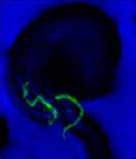News & Announcements
(January '08)

Along with Dr. Anja Geitmann at the University of Montreal, Canada, I wrote a peer-reviewed review article highlighting the various aspects of pollen tube guidance. Our goal for this article was to provide a comprehensive review of the knowledge gained so far in understanding how male and female cells communicate with each other to achieve fertilizations. This work has now been published as an invited review article in Floriculture and ornamental Biotechnology.
Reference:
Fertilization Requires Communication: Signal Generation and Perception During Pollen Tube Guidance
Anja Geitmann1, Ravishankar Palanivelu2
1 Institut de Recherche en Biologie Végétale, Département de Sciences Biologiques, Université de Montréal, 4101 rue Sherbrooke est, Montréal, Québec H1X 2B2, Canada
2 Department of Plant Sciences, Forbes 303B, University of Arizona, Tucson, Arizona, 85721, USA
Floriculture and Ornamental Biotechnology 1(2): 77-89.
Click here to access the pdf file of this article
Abstract:
The generation of novel hybrid lines is critically limited by the compatibility between pollen and pistil and their ability to achieve successful seed formation. Fertilization in flowering plants requires the successful transfer of the male gametes from the pollen grain to the egg contained within an ovule. This occurs via the formation of a tubular protrusion from the pollen grain – the pollen tube. This specialized structure grows extremely fast and has the complex task to invade the stigmatic and stylar tissues of the receptive flower, to find the ovary and an ovule, and to subsequently release the male gametes to the egg and central cell to achieve double fertilization. Failure of the pollen tube to penetrate the pistil or find its target results in the absence of fertilization and sterility. Understanding the signals that regulate the compatible interaction between a pollen tube and all the female cells in its path is therefore critical to generate tools for breeders in their quest to break species barriers and produce novel hybrids. In this review, we will discuss the signals and cues that guide pollen tubes to their targets, the mechanism of pollen tube growth and how the pollen tube readjusts its growth direction in response to these signals. In addition, we will present in vitro experimental strategies to study the pollen tube’s ability to find its target and/or the ovule’s capacity to attract or repulse a growing pollen tube.
---------------------------------------------------------------------------------
Click here for other announcements.
|